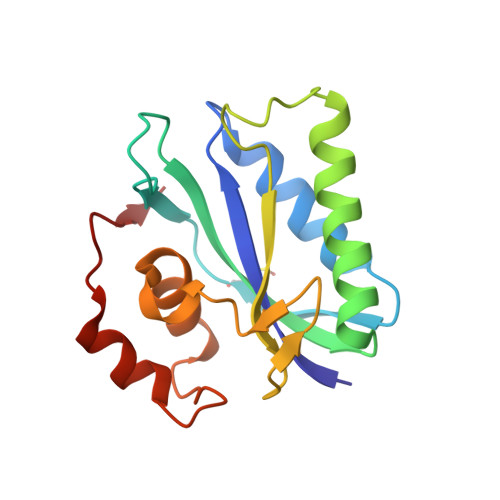Structure and activity of Yersinia pestis 6-hydroxymethyl-7,8-dihydropterin pyrophosphokinase as a novel target for the development of antiplague therapeutics.
Blaszczyk, J., Li, Y., Cherry, S., Alexandratos, J., Wu, Y., Shaw, G., Tropea, J.E., Waugh, D.S., Yan, H., Ji, X.(2007) Acta Crystallogr D Biol Crystallogr 63: 1169-1177
- PubMed: 18007032
- DOI: https://doi.org/10.1107/S0907444907047452
- Primary Citation of Related Structures:
2QX0 - PubMed Abstract:
6-Hydroxymethyl-7,8-dihydropterin pyrophosphokinase (HPPK) is a key enzyme in the folate-biosynthetic pathway and is essential for microorganisms but absent from mammals. HPPK catalyzes Mg(2+)-dependent pyrophosphoryl transfer from ATP to 6-hydroxymethyl-7,8-dihydropterin (HP). Previously, three-dimensional structures of Escherichia coli HPPK (EcHPPK) have been determined at almost every stage of its catalytic cycle and the reaction mechanism has been established. Here, the crystal structure of Yersinia pestis HPPK (YpHPPK) in complex with HP and an ATP analog is presented together with thermodynamic and kinetic characterizations. The two HPPK molecules differ significantly in a helix-loop area (alpha2-Lp3). YpHPPK has lower affinities than EcHPPK for both nucleotides and HP, but its rate constants for the mechanistic steps of both chemical transformation and product release are comparable with those of EcHPPK. Y. pestis, which causes plague, is a category A select agent according to the Centers for Disease Control and Prevention (CDC). Therefore, these structural and biochemical data are valuable for the design of novel medical countermeasures against plague.
Organizational Affiliation:
Macromolecular Crystallography Laboratory, National Cancer Institute, Frederick, MD 21702, USA.




















